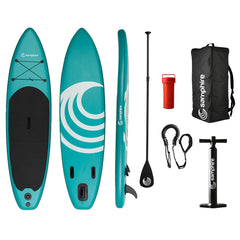
How To Choose Your Stand Up Paddleboard (SUP)
Where To Start?
When choosing your SUP there are many factors to consider. Your skill level, the type of riding you’ll be doing, preference and board construction in terms of the board’s size, capacity, volume, shape and price. Below we will discuss all the key factors you will need to know before choosing your board at SUP Warehouse.
1. INFLATABLE vs. SOLID
There are 2 types of paddle board; inflatable and solid.
Inflatable boards are especially convenient if you don't have much room for storing or transporting your SUP. These boards usually also come with a backpack which makes it even easier to transport. Inflating only takes 10 minutes and their durable construction means they can withstand the occasional bump.
Solid boards have little give and are much better suited to larger paddlers or if you are carrying extra gear. They also have less drag than inflatable boards so are able to slide through the water much easier.
2. BOARD SHAPE
The hull, or body, of a paddle board plays a major role in determining how the board performs in the water. Most SUPs have either a planing hull or a displacement hull.

Planing Hulls are flat and wide and designed to be very maneuverable which makes them the best choice for leisure paddling, surfing, yoga and whitewater.
Displacement Hulls slice through the water, pushing the water around the nose to the sides to improve efficiency and make for a faster ride. Therefore this board requires less effort to paddle than a planing hull. These boards are best for fitness paddling, SUP touring, SUP camping and racing.
3. SUP LENGTH
The length you choose largely depends on what you will use your board for. The general rule of thumb is longer boards are faster than shorter boards, but shorter boards are more maneuverable.

Short boards (under 10’) are the best for surfing and/or kids. These usually always have a planing hull.
Medium boards (10’ to 12’) are ideal for all-round use and SUP yoga. These boards come in a mix of planing and displacement hulls.
Long boards (12.6’ +) are the best for fast paddling and long-distance touring. These boards mainly have displacement hulls.
4. SUP WIDTH
The width of your board is an important consideration to take into account. For example, the wider the board, the more stable it'll be. But keep in mind that a wide board will be slower and more difficult to paddle. SUPs widths range from 25 inches up to 36 inches to accommodate various needs.
Consider:
- Type of paddling: longer tours may require more space to pack luggage. Racers and surfers may wish to have a more narrow. board to enable them to be faster and more manoeuvrable.
- Body Type: a smaller person requires a narrower board, to better find your balance and vice versa.
- Experience Level: Beginners may find a wider board makes them feel more comfortable, whereas more experienced paddlers may be fine with a narrower, faster SUP.
5. SUP THICKNESS
Once you have decided upon your length and width, next comes thickness. Thickness affects overall volume and weight capacity. The thicker the board, the more weight it can support.
For example, if you’re a small person and you want a long, displacement board. Choosing a thin board keeps the total volume of the board lower and therefore means you are properly weighting the board for most efficient performance.
6. SINGLE LAYER VS. DOUBLE LAYER
This is only a factor to consider with inflatable paddle boards. Materials used in paddleboard construction play a huge part on the boards performance, overall weight and durability.
Inflatable boards are made from PVC and can have a single or double layer construction. The general rule of thumb is that single layer allows for the boards to be easier to handle on the water and makes them more lightweight, therefore easier to transport. However, a double layer construction makes for a more durable paddleboard with stronger features. Combined, these factors increase the performance of the board and make it harder for it to be damaged. It is also important to note that some brands have developed and patented their own forms of board construction and these may differ from the traditional single/ double layer construction.
7. SUP FINS
In general, larger fins with wider bases and longer front edges track straighter and provide more stability than smaller fins.
There is a wide range of how your fins can be set up on your SUP. The most popular are:
Single Fin: This is one large fin directly in the back centre of the board near the tail. The fin itself can range from 8” to 10” in length, helping the board to track along the water and face any waves whilst surfing
2+1: This configuration means that there is a larger fin in the centre and two smaller fins on each side. This is a common setup for surfing.
3 Fin: This setup offers good control in surf and helps straight tracking on flatwater, also known as a thruster. All 3 fins are the same size.
NOTE: Inflatable SUPs are able to have any of the fin setups listed. The key difference is the fins are either detachable or made from a flexible rubber.
With all this in mind, you should now be able to shop at SUP Warehouse with confidence and determine which SUP is for you. If you still feel like you need more help, please contact us at support@sup-warehouse.com or visit our social media pages and reach out to us!



